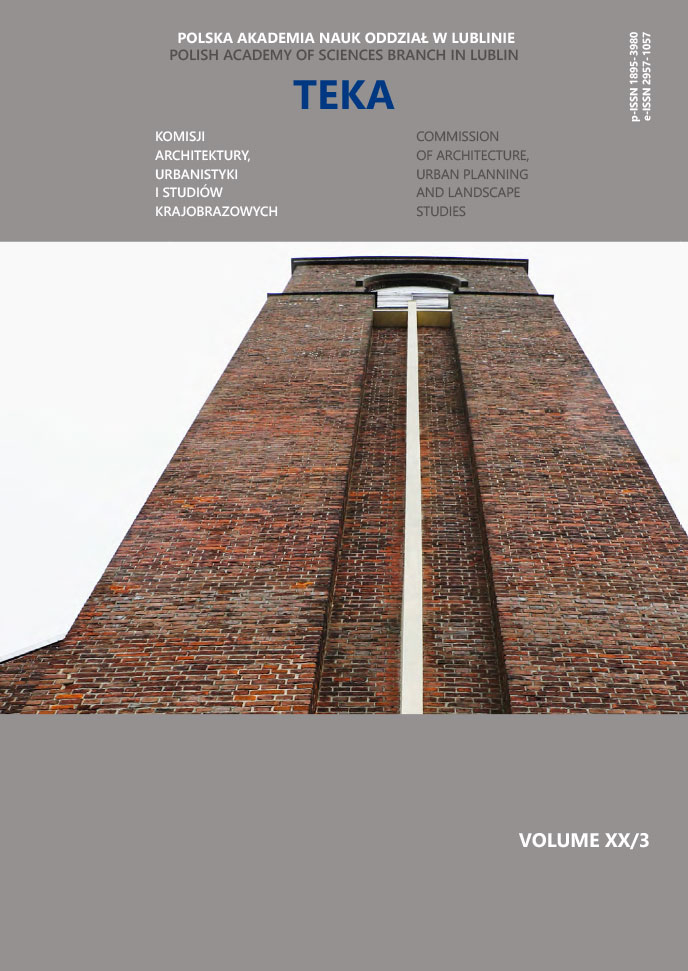Wpływ architektury i urbanistyki na psychikę jako metoda zapobiegania przestępstwom
Michał Skorupski
Instytut Psychologii Stosowanej, Uniwersytet Jagielloński (Polska)
Joanna Jabłońska
Wydział Architektury, Politechnika Wrocławska (Polska)
Abstrakt
Ponad połowa populacji świata żyje obecnie w miastach, gdzie gęsta zabudowa otacza jednostkę i sprawia, że architektura staje się nieodłącznym elementem jej życia. Pomimo, że wpływ architektury i urbanistyki na funkcjonowanie i psychikę człowieka wydaje się być oczywisty, badania na ten temat zaczęto prowadzić zaledwie ponad pół wieku temu. Stąd, niniejszy artykuł poświęcono prezentacji wiadomości na temat relacji pomiędzy sposobem kształtowania planów zagospodarowania terenu i budynków, a bezpieczeństwem i komfortem mieszkańców miast. Skoncentrowano się na aspekcie gęstości i wysokości zabudowy, rozwiązaniach zieleni miejskiej i sposobach urządzania przestrzeni, nakierowanych na poprawę i humanizację warunków mieszkaniowych, celem dbałości o psychikę oraz zdrowie fizyczne mieszkańców miast.
Słowa kluczowe:
psychologia w architekturze, psychologia architektury, człowiek a budynek, człowiek a urbanistyka, współczesna psychologia, współczesna architekturaBibliografia
Fiałkowski W. (1981). Siedmiu architektów XX wieku. Warszawa: Krajowa Agencja Wydawnicza.
Google Scholar
Zhu R., Meyer-Levy J. (2007). The Influence of Ceiling Height: The Effect of Priming on the Type of Processing That People Use. Joural of Consumer Research, 34.
Google Scholar
Mehta R., Zhu R. (2009). Blue or red? Exploring the effect of color on cognitive task performances. Science, 323.
DOI: https://doi.org/10.1126/science.1169144
Google Scholar
Gifford R. (2007). The Consequences of Living in High-Rise Buildings. Architectural Science Review, 50.
DOI: https://doi.org/10.3763/asre.2007.5002
Google Scholar
Newman O. (1975). Reactions to the “defensible space” study and some further findings. International Journal of Mental Health, 4.
DOI: https://doi.org/10.1080/00207411.1975.11448692
Google Scholar
Smith J. (2000) The space of local control in the devolution of US public housing policy. Geografiska Annaler, 83.
Google Scholar
Sommer R. (1987) Crime and vandalism in university residence halls: a confirmation of defensible space theory. Journal of environmental psychology, 7.
DOI: https://doi.org/10.1016/S0272-4944(87)80041-5
Google Scholar
Thani S.K.S.O., Hashim H.M., Ismail W.H.W. (2016) Surveillance by Design: Assessment using principles of Crime Prevention through Environmental Design (CPTED) in urban parks. Procedia – Social and Behavioral Sciences 234. (s. 506−516).
DOI: https://doi.org/10.1016/j.sbspro.2016.10.269
Google Scholar
Katyal N.K. (2002). Architecture as crime control. Yale Law Journal, 111.
DOI: https://doi.org/10.2307/797618
Google Scholar
Sherman L.W. (1995) Hot spots of crime and criminal careers of places. W: Eck J.E., Weisburd D. Crime and Place: Crime Prevention Studies. (s. 35−52)
Google Scholar
Newman O. (1996). Creating Defensible Space.
Google Scholar
Donelly P.G. (2010). Newman Oscar: Defensible Space Theory. Sociology, Anthropology, and Social Work Faculty Publications, 30.
DOI: https://doi.org/10.4135/9781412959193.n185
Google Scholar
Lidwell W., Holden K. (2003). Universal Principles of Design. Beverly: Rockport Publishers. (s 71−72).
Google Scholar
Caplan J.M., Keneddy L.W. (2010). Risk Terrain Modeling Manual.
Google Scholar
Caplan J.M., Kennedy L.W., Barnum J.D., Piza E.L. (2017). Crime in Context: Utilizing Risk Terrain Modeling and Conjunctive Analysis of Case Configurations to Explore the Dynamics of Criminogenic Behavior Settings. Journal of Contemporary Criminal Justice, 2 (33).
DOI: https://doi.org/10.1177/1043986216688814
Google Scholar
Caplan J.M., Kennedy L.W., Piza E.L. (2015). A Multi-jurisdictional Test of Risk Terrain Modeling and a Place-based Evaluation of Environmental Risk-Based Patrol Deployment Strategies [online]. Rutgers University. Dostęp: http://www.rutgerscps.org/uploads/2/7/3/7/27370595/nij6city_resultsexecsum_final.pdf(29.12.2017).
Google Scholar
Kennedy L.W., Caplan J.M., Piza E.L. (2015). Conjunctive Analysis Report: 2012 Shootings in Chicago, IL [online].Rutgers University. Dostęp: http://www.rutgerscps.org/uploads/2/7/3/7/27370595/cpd_conjanalysis.pdf (28.04.2018).
Google Scholar
Zavorski R.W., Lapidus G.D., Lerer T.J, Burke G., Banco L. (1999). Evaluating the impact of a street barrier on urban crime. Injury Prevention, 5.
Google Scholar
Kamin B. (2015). Architect Jeanne Gang’s vision expands from the skyscraper to the police station [online]. Chicago Tribune. Dostęp: http://www.chicagotribune.com/entertainment/ct-jeanne-gang-architecture-polis-station-ae-1115−20151113-story.html (28.04.2018).
Google Scholar
Strona internetowa pracowni projektowej Studio Gang. Dostęp: http://studiogang.com/project/polis-station (26.04.2018).
Google Scholar
Marklund J., Ahrberg S. (2017) Evaluation of an area in Sweden using Crime Prevention Through Environmental Design (CPTED). Źródło – strona internetowa Mid Sweden University (dostęp 2.02.2018) https://miun.diva-portal.org/smash/get/diva2:1153996/FULLTEXT01.pdf
Google Scholar
Winstanley T (2011) AD Classics: Trellick Tower / Erno Goldfinger Archdaily [online]. Dostęp: https://www.archdaily.com/151227/ad-classics-trellick-tower-erno-goldfinger (10.06.2018)
Google Scholar
Whitzman C. (2001) Social Infrastructure in Tall Buildings: A Tale of Two Towers. CTBUH Research Paper, Melbourne: CTBUH
DOI: https://doi.org/10.4324/NOE0415232418.ch3
Google Scholar
Autorzy
Michał SkorupskiInstytut Psychologii Stosowanej, Uniwersytet Jagielloński Polska
Autorzy
Joanna JabłońskaWydział Architektury, Politechnika Wrocławska Polska
Statystyki
Abstract views: 349PDF downloads: 322




